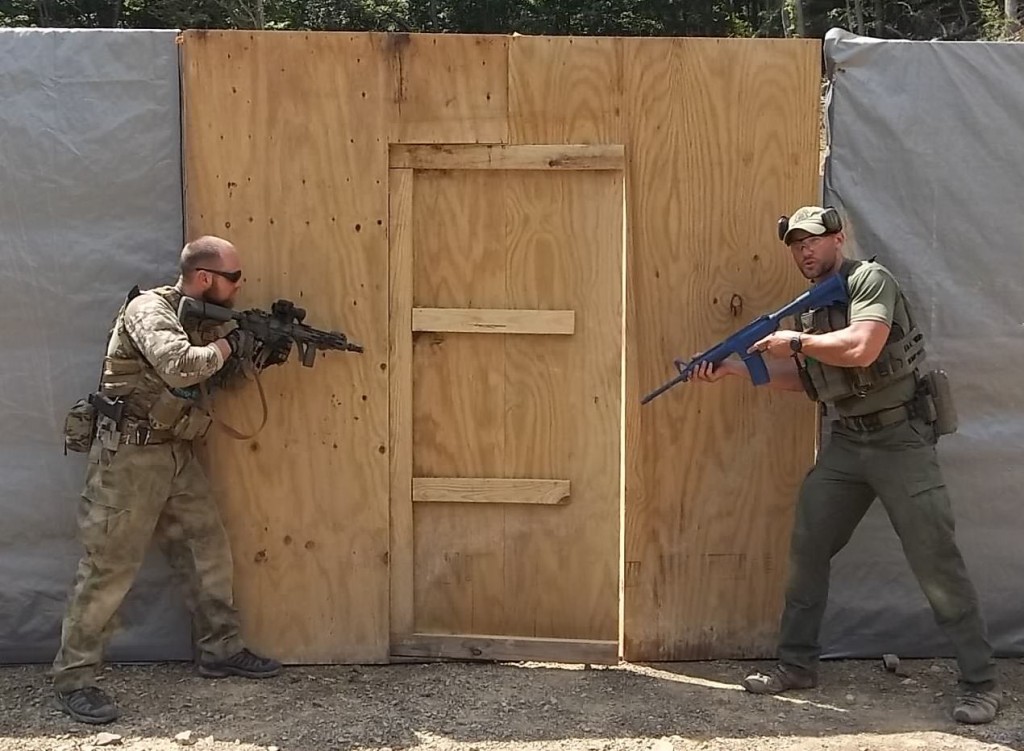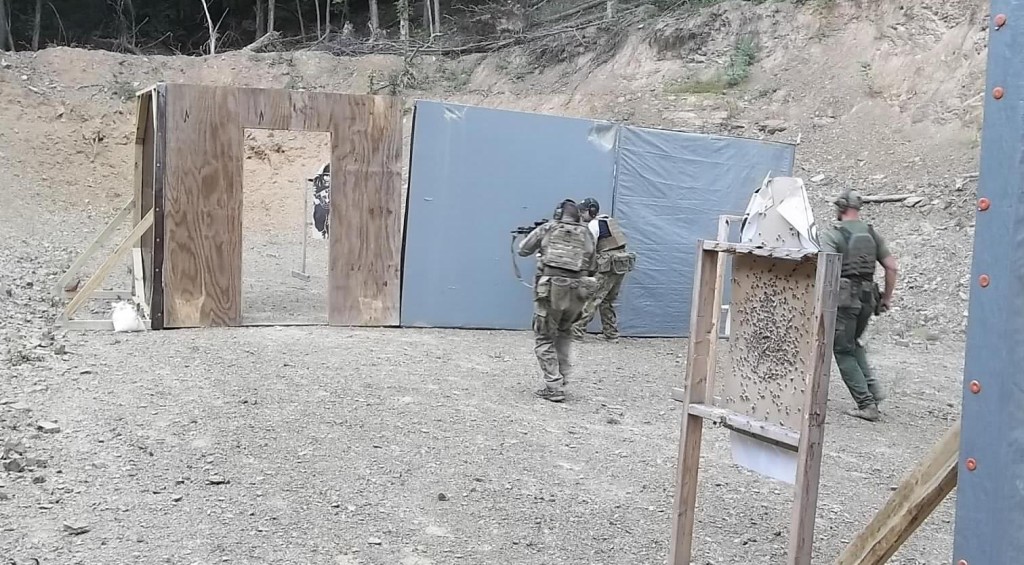Student Review: Citizen Close Combat (C3) Sept 26-27: JARG
Sept. 26-27 Citizen Close Combat (C3) Class AAR – JustARandomGuy
Nuance.
You hear people all the time say “the devil is in the details”.
How hard is it to hit a paper plate sized “hit” zone from a mere ten yards away?
Now apparently there’s been some misconception that classes like this are just training unskilled shooters to spray and pray. Umm.. no. I’ll get into this a little more later, but this is not a “have fun shooting lots of ammo” type of “CQB” class. Further, I’m not going to claim to be a shooting expert, but I have no problem hitting a paper plate sized hit zone at combat ranges, let alone a mere ten yards, and maintaining an acceptably tight group.
We also did do dry runs before going live (as usual) and a couple drills were not even run live-fire, because of the angles involved.
But… going off the three types of shooting reviewed in the class- single shot, cadence, and “stream” fire, my whole shooting background has been accuracy based, and therefore revolved around single aimed shots, and cadence fire.
Which brings me to the point about nuance, where it’s the small cogs that count- if there is a gap in your skill set, this class WILL bring it to the fore, even if you’ve already been to other training. I remember my first CTT (back when it was still CRCD), and the “lightbulb” effect if had on the mind afterwards. If you had that same “lightbulb” effect, then the C3 class is like a second “lightbulb” moment going on.
Not only because of the things you’ll find out about yourself, but because of the actual class material.
I’m not going to go into what we actually learned too much because this will turn into ten pages (and that would be the KISS version), and I want to retain the element of surprise for further students. But if you’ve spent any time at all in the tactical shooting community, a lot of the courses, drills, and instruction out there these days are tailored around close quarters fighting, whether for SWAT, Military, or CCW’ers.
Here on MVT, you’ll hear a lot of talk about how much of the square range training is a “false positive” if you will, and how there’s a lot of flashy stuff that seems useful but isn’t.
Once you get out on the range with Lee and you’re going through the course, and you hear and see how things need to be done to be effective, and then have the direct comparison drawn to examples from the mainstream tactical side of this, you will understand why a lot of that is counterproductive.
I want to go so far as to say it’s almost something that can’t be truly conveyed in words across the internet, but standing there between the “buildings” going through an entry or movement drill, and having the “why” of it explained you’re going to be like “Lightbulb!”
Going a little further, they say urban operations are manpower intensive- you don’t realize *how* much until actually doing it- this “team” stuff always being pushed here on MVT and similar sites… turns out that’s actually really useful, if you hadn’t already noticed during CTT… CQB is also a lot more mentally intensive- more potential movements and angles that affect your own movements and angles to think about, and everything happens much faster. The more people you have, the better your angles can be covered, and the more options you have in a “situation”. If your potential situation has yourself as the only gun up front with non-armed, helpless, and/or tactically clueless others in tow, this will really hit home.
But this is really important stuff to think about because how many folks live in an urban area? What if you decide to shelter in place post-event, or need to bugout from a city, or pass through such on the way to a retreat? These are things you need to know, as much as CTT, and it really all goes hand in hand once you start put it all together and realize you can’t have one without the other.
About the instructor- Lee apparently has infinite levels of patience given the amount of wrangling it took us to get some of the instruction, and a great sense of sarcasm when explaining things as well. It’s one of those things where you’ll laugh about it, and at the same time be like “this is so obvious, why didn’t I think of it like that.” And the previous about this AAR going to ten pages- we could have easily spent two days just discussing the material before firing a single round- Lee evidently has the background for it. Further, the information presented wasn’t just a “here’s what to do, now do it” formula, there was a lot more “why” behind it- examples of “here’s how we did it before in the Major League Doorkickers, here’s why it didn’t work and the better techniques we developed.”
Some people are going to look at this being an Alumni-only class and say that it’s limiting the number of potential attendees, and you could make that argument, however, MVT was right to do so, as this is not a class for those new to their equipment, or working around other people. Coming from a more mainstream “run the gun” tactical shooting background, I figured this would be easier than CTT, but I blue-screened plenty, even on things I can do well any other day of the week.
For potential attendees; here’s some things to think about pre-class;
Fundamentals: practice reloads, malfunction clearance, height over bore offset, rapid fire with accuracy, sling use and shoulder transitions. Lee apparently delights in making right handed shooters shoot lefty (it seems he is an asshole too). But what better time to do it then at training where you can get immediate feedback on what you’re doing, and I did see marked improvement just within two days.
Gear setup: no loose pouches-make sure your gear is attached correctly so you’re not fighting with it. No flaps on the magazine pouches (or tuck them behind if you have elastic-banded pouches that will still retain the mags without the flap, like most double-M4 pouches), have at least some ammo reachable with either hand, a dump pouch may be useful if you have difficulty with tight mag pouches.
Round count: I spent approx. 640 rounds, plus a magazine or two of pistol ammo.
There can be plenty of opportunity to shoot more pistol ammo on day 2 if you start using partial rifle mags, but I wanted to focus on the class material as this was new to me and the confidence level wasn’t quite there. Further, while I wasn’t being stingy with the rifle ammo, you could easily spend more if stream fire really clicks for you.
So why should you attend this class? The answer is as stated in the first sentence.
Nuance- how something is done is often more important than what is done- anyone can run into a room and dump rounds into a target while screaming ‘Merica! and call it “CQB training”.
For my fellow shooters out there in the tactical shooting community who may stumble across this and read it;
If you’re going to a CQB-oriented class just to shoot lots of rounds at targets at close range, you’re at the wrong class.
If you think your current ability to dump lots of rounds into multiple targets on the line while running your gun at lightning speed between targets equals skill at CQB, you’re wrong, and you’re probably not as good as you thought.
I can hear the panties bunching over that last sentence so let me expound; be a rockstar with your weapon by all means. It can only help.
But the moment your high-speed sling gets tangled around everything as you attempt to run a shoulder transition you thought you were good enough at, or you forget to transition to your handgun when needed which you can do like a machine on a regular day but blue-screened on doing here because you got mindf***ed by all the other things you’re trying to do or assimilate on the way into the room… you’ll understand what I’m saying. You can practice something a certain way ad nauseum and be considered skilled, but then one part of the equation changes and suddenly you’re not that good.
Because the fact is, all that shouldn’t even matter- it’s just background noise to you and/or your team’s ability to understand the unfolding situation and act correctly (or at least pick the lesser evil path) that equals skill. This class will help give you that understanding.
So in short, if you left CTT feeling like it was worth every dollar you paid for it, or you’re looking for “beyond the shooting” CQB instruction, you should take this class. And may the angles be ever in your favor.


